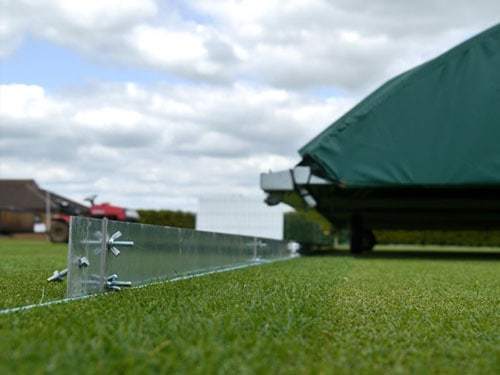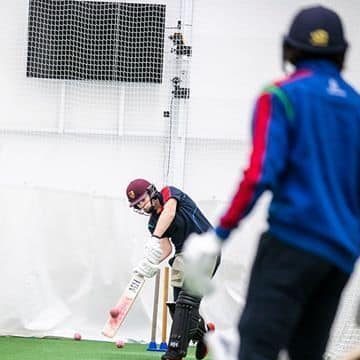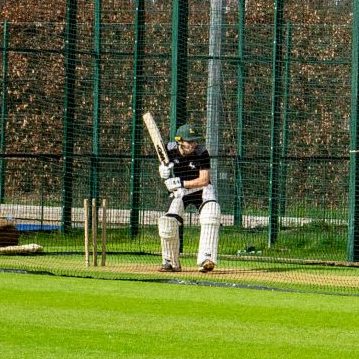Durant Cricket continue their commitment to doing all they can to help clubs get as much cricket on as possible with the design and manufacture of the Run Bund wicket protection system that offers multiple benefits to clubs at all levels.
The Run Bund consists of a set of steel strips that are simply joined together and tapped in alongside the wicket prevent unwanted water getting onto the pitch – which could have disastrous consequences.
Download our
2021 Catalogue
Ut a rhoncus purus. Morbi pretium id elit sit amet tincidunt.

Supplied as a set of nine strips that are 8 feet long and 75mm high, they provide 21 metres of coverage – enough to also protect the bowlers’ landing areas. Plus, 4-foot long strips are also available so even pitches which are uneven can be protected.
Keith Exton, head groundsman at Grantham Cricket Club has already been using the Run Bund and explains why the system makes perfect sense any club trying to beat the bad weather and get as much cricket played as possible.
“The Run Bund has been engineered specifically for grass roots cricket to save a lot of sheeting,” he says.
“Most clubs haven’t got the labour or the manpower to deal with big flat sheets – 30 or 40 footers – so this in itself takes that problem away but also lets the rest of your square have a drink but saves your match pitch from water running underneath the covers.
“Even if you’ve got smaller sheets you could have a 10-foot sheet by the side which is manageable and then put these bunds out on the other side of the 10-foot so you’ve got the bowlers’ run-ups safe as well.
“To stop the water running is the most important thing because invariably all squares have got some kind of fall on them, whether they are with play or across play, and that in turn always seems to run underneath the covers on a length – always. I don’t know why, but it does!”
For Exton, using the Run Bund in place of large flat sheets, which can be expensive and labour-intensive, is a no-brainer and he believes this system will keep most games on as well as improve the health of your playing surface.
“A set of nine comes out at £295 plus VAT. In comparison with flat sheets, a 40-foot flat sheet climate cover you will be paying £3,500 + VAT,” he explains.
“If you can do away with sheets you do away with disease problems, you do away with manpower and your grass tends to be a lot healthier if it does get a drink
“If there is torrential rain about and you want to save a match, you’ve got to cover but for thunderstorms that are forecast overnight, we believe that these would save the game for a 1pm or 1.30pm start.
“The rest of your square will have had water, obviously, and it might get a little scarred but you’ll get your game of cricket on which is the most important thing.”
Not all squares are the same, however, and Exton adds that this is why custom options are available for groundsmen, making the Run Bund fit for any club, on top of being very easy to use.
“These are quite simply 75mm high and 8 foot long, they join in the middle with three pegs that hold them as well. You simply tap them into the ground, going in 2-3mm,” Exton details.
“If you’ve got a lot of undulation you’ll have points where you’ve gone in a little bit deeper but predominantly a cricket table is reasonably flat through the middle.
“It’s the saddles on the end that you might have to knock in somewhat deeper to stop the ingress.
“Because the bund pieces do pivot on the joint, Durant have looked into that and decided to have some halves manufactured so it follows the contour more evenly. Yes, that means more joints but the joints are waterproof anyway.”
Although the standard kit comes as a set of nine strips, Durant can provide any club with the exact number of strips they need – and any combination of 4 and 8-foot long strips.
“They are manufactured as a set of nine but you could have 10, 20, 30, however many you want, so there’s no problem.
“It’s really about knowing your own levels on your own square to judge how many you need to purchase.”
And you won’t need any fancy tools or machinery to put this system in place, either – a mallet or small hammer is enough along with some string to mark your course to make sure you leave enough room to safely manoeuvre your covers into place.
“Basically you either need a rubber mallet or a small ball peen hammer. If you want to knock them in a bit deeper you need a little bit more weight, but predominantly a rubber mallet is sufficient and that saves the edges of the bund itself.
“They come with the legs and the bolts all separate and once they are all put together they can be stored flat and obviously just work them in and look after them. They are galvanised so they are going to last quite a few years without rusting.
“It’s so simple, and hopefully will be an aid to getting the game on,” Exton concludes.
Request a call back

If you’re interested in our offer, please fill in the below form and we will get in touch with you to discuss your project.



















